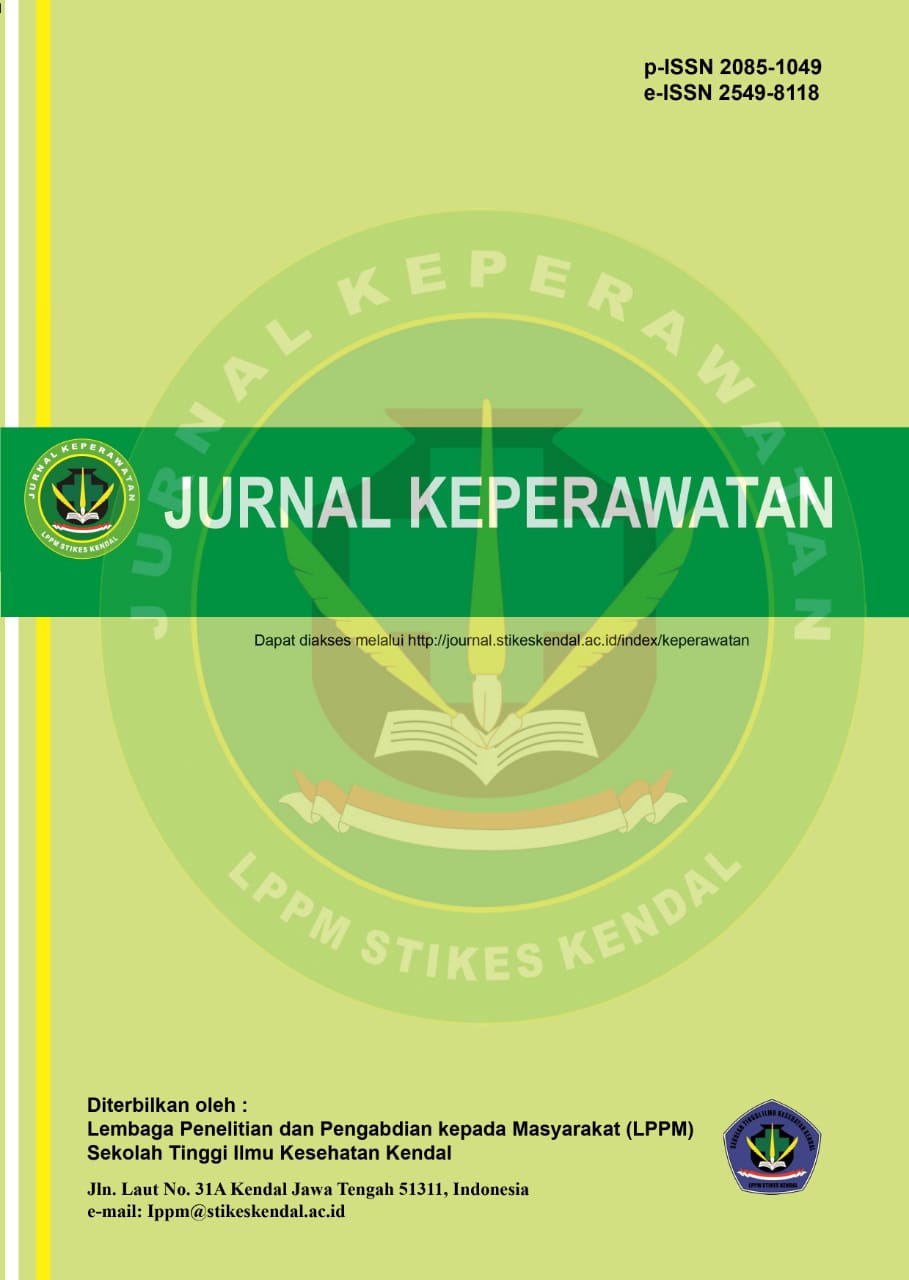Pengkajian Tingkat Keparahan CSA-AKI Berdasarkan Kriteria Kdigo: Literature Review
DOI:
https://doi.org/10.32583/keperawatan.v15i4.1287Keywords:
cardiac surgery associated acute kidney injury, instrument, pengkajianAbstract
Operasi bedah jantung meningkatkan resiko kejadian Cardiac Surgery Associated Acute Kidney Injury. Kondisi ini dapat mengakibatkan kerusakan ginjal permanen bahkan bisa berakibat kematian. Perlu dilakukan pengkajian yang baik dan benar untuk mencegah terjadinya kesakitan dan kematian, diantaranya dengan mengembangkan instrumen yang dapat digunakan untuk mengkaji tingkat keparahan. Tujuan dari studi literatur ini adalah untuk mengumpulkan referensi teori pendukung yang memperkuat pengembangan intrumen pengkajian tingkat keparahan berdasarkan kriteria Kidney Disease: Improving Global Outcomes. Desain penulisan yang digunakan yaitu narrative literature review. Pencarian artikel atau jurnal menggunakan search engine: science direct, Springer link, EBSCO, proquest. Sintesa data menggunakan matrik sintesis melalui Preferred Reporting Items for Systematic Reviews and Meta-Analyses flow chart. Critical Appraisal Skills Program digunakan untuk menganalisis kualitas artikel yang dipilih. Artikel ditemukan sebanyak 9 artikel. Pengkajian tingkat keparahan tetap menggunakan kombinasi serum kreatinin dan produksi urin. Durasi utama pengkajian adalah selama 72 jam setelah operasi jantung. Penerapan pelaporan yang seragam dapat menurunkan variasi insiden. Kidney Disease: Improving Global Outcomes lebih prediktif. Pengembangan instrumen pengkajian tingkat keparahan meliputi produksi urin, kreatinin serum, waktu pengkajian dan pelaporan hasil pengkajian.
References
Bellomo, R. et al. (2004) ‘Acute renal failure - definition, outcome measures, animal models, fluid therapy and information technology needs: the Second International Consensus Conference of the Acute Dialysis Quality Initiative (ADQI) Group.’, Critical care (London, England), 8(4). doi: 10.1186/cc2872.
Critical Appraisal Skills Programme (2018) ‘CASP Checklist: 12 questions to help you make sense of a Cohort Study’, CASP checklists Oxford, (2018), pp. 1–7. Available at: http://www.casp-uk.net/casp-tools-checklists.
Critical Appraisal Skills Programme (2020) ‘CASP Randomised Controlled Trial Standard Checklist’, CASP checklists Oxford, (2020), pp. 1–7. Available at: http://www.casp-uk.net.
Dedemoglu, M. and Tuysuz, M. E. (2020) ‘Risk estimation model for acute kidney injury defined by KDIGO classification after heart valve replacement surgery’, General Thoracic and Cardiovascular Surgery, pp. 922–931. doi: 10.1007/s11748-019-01278-1.
Grynberg, K. et al. (2017) ‘Early serum creatinine accurately predicts acute kidney injury post cardiac surgery’, BMC Nephrology, 18(1), pp. 1–7. doi: 10.1186/s12882-017-0504-y.
Hidayat, H., Pradian, E. and Kestriani, N. D. (2020) ‘Angka Kejadian, Lama Rawat, dan Mortalitas Pasien Acute Kidney Injury di ICU RSUP Dr. Hasan Sadikin Bandung’, Jurnal Anestesi Perioperatif, 8(2), pp. 108–118. doi: 10.15851/jap.v8n2.2054.
Howitt, S. H. et al. (2018) ‘The KDIGO acute kidney injury guidelines for cardiac surgery patients in critical care: A validation study’, BMC Nephrology, 19(1), pp. 1–8. doi: 10.1186/s12882-018-0946-x.
Just, I. A. et al. (2022) ‘Cardiac Surgery Related Acute Kidney Injury - Risk Factors , Clinical Course , Management Suggestions’, Journal of Cardiothoracic and Vascular Anesthesia, 36(2), pp. 444–451. doi: 10.1053/j.jvca.2021.05.012.
Kalender, M. et al. (2019) ‘Validation of Renal Risk Score Models for Coronary Artery Bypass Surgery in Diabetic Patients’, Heart Lung and Circulation, 28(5), pp. 800–806. doi: 10.1016/j.hlc.2018.03.029.
KDIGO (2012) ‘KDIGO Clinical Practice Guideline for Acute Kidney Injury’, Kidney International Supplements, 1(1), pp. 7–14. doi: 10.3810/hp.2014.02.1086.
Kellum, J. A. et al. (2021) ‘Acute kidney injury’, Nature Reviews Disease Primers, 7(1). doi: 10.1038/s41572-021-00284-z.
Lakhal, K. et al. (2021) ‘Early recognition of cardiac surgery- associated acute kidney injury : lack of added value of TIMP2 IGFBP7 over short-term changes in creatinine ( an observational pilot study )’, pp. 1–13.
Lameire, N. H. et al. (2021) ‘Harmonizing acute and chronic kidney disease definition and classification: report of a Kidney Disease: Improving Global Outcomes (KDIGO) Consensus Conference’, Kidney International, 100(3), pp. 516–526. doi: 10.1016/j.kint.2021.06.028.
Leballo, G. and Chakane, P. M. (2020) ‘Cardiac surgery-associated acute kidney injury: Pathophysiology and diagnostic modalities and management’, Cardiovascular Journal of Africa, 31(4), pp. 205–212. doi: 10.5830/CVJA-2019-069.
Meersch, M. et al. (2017) ‘Prevention of cardiac surgery ‑ associated AKI by implementing the KDIGO guidelines in high risk patients identified by biomarkers : the PrevAKI randomized controlled trial’, Intensive Care Medicine. doi: 10.1007/s00134-016-4670-3.
Meersch, M. and Zarbock, A. (2017) ‘Prevention of cardiac surgery-associated acute kidney injury’, Current Opinion in Anaesthesiology, 30(1), pp. 76–83. doi: 10.1097/ACO.0000000000000392.
Mehta, R. L. et al. (2007) ‘Acute kidney injury network: Report of an initiative to improve outcomes in acute kidney injury’, Critical Care, 11(2), pp. 1–8. doi: 10.1186/cc5713.
Mizuguchi, K. A. et al. (2018) ‘Predicting kidney disease progression in patients with acute kidney injury after cardiac surgery’, Journal of Thoracic and Cardiovascular Surgery, 155(6), pp. 2455-2463.e5. doi: 10.1016/j.jtcvs.2018.01.093.
Ostermann, M. et al. (2021) ‘Cardiac surgery associated aki prevention strategies and medical treatment for csa-aki’, Journal of Clinical Medicine, 10(22), pp. 8–10. doi: 10.3390/jcm10225285.
PERNEFRI (2018) ‘11th Report Of Indonesian Renal Registry 2018’, Indonesian Renal Registry (IRR), pp. 1–46. Available at: https://www.indonesianrenalregistry.org/data/IRR 2018.pdf.
Silva, T. F. da et al. (2021) ‘Incidence of acute kidney injury post cardiac surgery: a comparison of the AKIN and KDIGO criteria’, Brazilian Journal of Anesthesiology (English Edition), 71(5), pp. 511–516. doi: 10.1016/j.bjane.2021.02.016.
Tsai, T. Y. et al. (2017) ‘Comparison of RIFLE, AKIN, and KDIGO classifications for assessing prognosis of patients on extracorporeal membrane oxygenation’, Journal of the Formosan Medical Association, 116(11), pp. 844–851. doi: 10.1016/j.jfma.2017.08.004.
Ulger, F. et al. (2018) ‘Evaluation of acute kidney injury (AKI) with RIFLE, AKIN, CK, and KDIGO in critically ill trauma patients’, European Journal of Trauma and Emergency Surgery, 44(4), pp. 597–605. doi: 10.1007/s00068-017-0820-8.
Vandenberghe, W. et al. (2016) ‘Acute kidney injury in cardiorenal syndrome type 1 patients: A systematic review and meta-analysis’, CardioRenal Medicine, 6(2), pp. 116–128. doi: 10.1159/000442300.
Wiersema, R. et al. (2020) ‘Different applications of the KDIGO criteria for AKI lead to different incidences in critically ill patients: A post hoc analysis from the prospective observational SICS-II study’, Critical Care, 24(1), pp. 1–8. doi: 10.1186/s13054-020-02886-7.
Wu, M. Z. et al. (2018) ‘Predictive value of acute kidney injury for major adverse cardiovascular events following tricuspid annuloplasty: A comparison of three consensus criteria’, Journal of Cardiology, 72(3), pp. 247–254. doi: 10.1016/j.jjcc.2018.01.018.
Yang, L. (2017) ‘Acute Kidney Injury in Asia’, Kidney Diseases, 2(3), pp. 95–102. doi: 10.1159/000441887.
Downloads
Published
How to Cite
Issue
Section
License
Copyright (c) 2023 Jurnal Keperawatan

This work is licensed under a Creative Commons Attribution-NonCommercial-NoDerivatives 4.0 International License.




